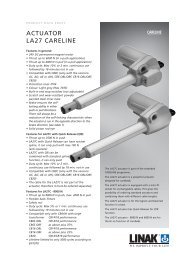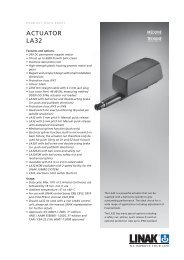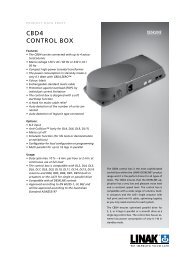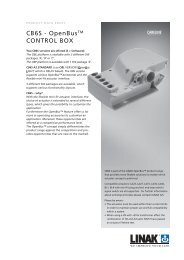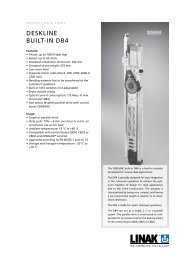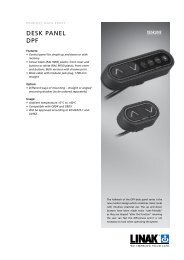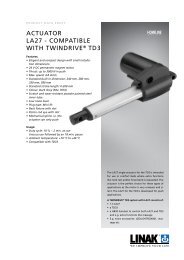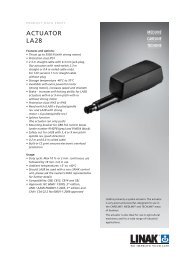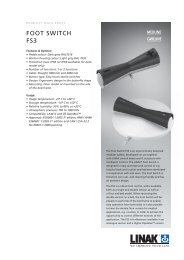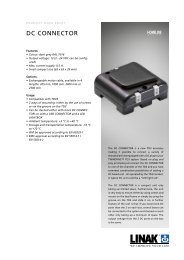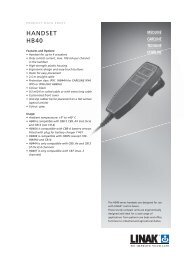You also want an ePaper? Increase the reach of your titles
YUMPU automatically turns print PDFs into web optimized ePapers that Google loves.
USER MANUAL<br />
<strong>Controls</strong>/<strong>Handsets</strong><br />
To learn more about LINAK please visit:<br />
WWW.LINAK.COM<br />
Page 1 of 40
Page 2 of 40
Contents<br />
Preface................................................................................................................................................................... 4<br />
Safety instructions................................................................................................................................................ 5<br />
Repairs................................................................................................................................................................... 7<br />
Manufacturer’s declaration.................................................................................................................................. 7<br />
Misc. on the DESKLINE ® system........................................................................................................................... 8<br />
Warranty.......................................................................................................................................................... 8<br />
Maintenance.................................................................................................................................................... 8<br />
ETL-marking........................................................................................................................................................... 8<br />
Mounting guidelines for DPA/DPB ................................................................................................................... 10<br />
Operation of the DP1.......................................................................................................................................... 11<br />
Operation of the DP1C....................................................................................................................................... 13<br />
Remote control HB10RF / HB20IR...................................................................................................................... 15<br />
Activating the learning mode.......................................................................................................................... 16<br />
Operation of the DPF.......................................................................................................................................... 17<br />
K-version........................................................................................................................................................ 17<br />
M-version....................................................................................................................................................... 17<br />
Operation of the DPF1C “one reference”.......................................................................................................... 18<br />
Operation of the DPF4T “multiple references”................................................................................................. 19<br />
Other functions common for DPF1C and DPF4T.............................................................................................. 20<br />
Mounting of all DPF versions............................................................................................................................. 21<br />
Drawings of the mounting brackets................................................................................................................ 22<br />
Operation of the DPT.......................................................................................................................................... 23<br />
Mounting of the DPT.......................................................................................................................................... 25<br />
Operation of the WDPL...................................................................................................................................... 26<br />
Calibrating the WDPL..................................................................................................................................... 27<br />
Adjusting the clock......................................................................................................................................... 28<br />
Troubleshooting.............................................................................................................................................. 28<br />
Store a memory position................................................................................................................................. 29<br />
Switch to a stored memory position................................................................................................................ 30<br />
Disposal of LINAK’s products ............................................................................................................................ 31<br />
Disposal of batteries........................................................................................................................................... 31<br />
Labels .................................................................................................................................................................. 32<br />
Drawing appendix.............................................................................................................................................. 33<br />
Addresses............................................................................................................................................................ 40<br />
Page 3 of 40
Preface<br />
We are delighted that you have chosen a product from LINAK A/S. LINAK ® systems are high-tech products<br />
based on many years of experience in the manufacture and development of actuators, electronic control<br />
boxes, controls, and chargers. We are also constantly improving our products to meet customer requirements.<br />
This User Manual will tell you how to install, use and maintain your LINAK DESKLINE ® products.<br />
We are sure that the DESKLINE products will give you many years of problem-free operation. Before our<br />
products leave the factory they undergo full function and quality testing. Should you nevertheless experience<br />
problems with your systems, you are always welcome to contact our service departments or service centres.<br />
LINAK subsidiaries and distributors all over the world have authorised service centres, which are always ready<br />
to help you.<br />
LINAK provides a warranty on all its products. This warranty, however, is subject to correct use in accordance<br />
with the specifications, maintenance being done correctly and any repairs being carried out at a service<br />
centre, which is authorised to repair LINAK products.<br />
Changes in installation and use of LINAK systems can affect their operation and durability. Changes must<br />
therefore only be made by agreement with LINAK A/S and are made at your own risk.<br />
LINAK A/S<br />
Page 4 of 40
Important information<br />
Important information on LINAK ® products can be found under the<br />
following headings:<br />
Warning!<br />
Failure to comply with these instructions may result in accidents<br />
involving serious personal injury.<br />
Failing to follow these instructions can result in the product being<br />
damaged or being destroyed.<br />
Safety instruction<br />
General<br />
Safe use of the system is possible only when the operating instructions<br />
are read completely and the instructions contained are strictly observed.<br />
Failure to comply with instructions marked with the ”NOTE” symbol may<br />
result in serious damage to the system or one of its components.<br />
It is important for everyone who is to connect, install, or use the<br />
systems to have the necessary information and access to this User<br />
Manual. Follow the instructions for mounting – risk of injury if<br />
these instructions are not followed.<br />
The appliance is not intended for use by young children or infirm<br />
persons without supervision.<br />
If there is visible damage on the product it must not be installed.<br />
Note that during construction of applications, in which the actuator<br />
is to be fitted, there must be no possibility of personal injury, for<br />
example the squeezing of fingers or arms.<br />
Assure free space for movement of application in both directions to<br />
avoid blockade.<br />
Page 5 of 40
Only for EU markets<br />
This appliance can be used by children aged from 8 years and<br />
above and persons with reduced physical, sensory or mental<br />
capabilities or lack of experience and knowledge if they have given<br />
supervision or instruction concerning use of the appliance in a safe<br />
way and understand the hazards involved.<br />
Children shall not play with the appliance. Cleaning and user<br />
maintenance shall not be made by children without supervision.<br />
Only for Non EU markets<br />
Persons who do not have the necessary experience or knowledge of<br />
the product/products must not use the product/products. Besides,<br />
persons with reduced physical, sensory or mental abilities must not<br />
use the product/products, unless they are under surveillance or they<br />
have been thoroughly instructed in the use of the apparatus by a<br />
person who is responsible for the safety of these persons.<br />
Moreover, children must be under surveillance to ensure that they<br />
do not play with the product.<br />
Misuse<br />
Do not overload the actuators – this can cause danger of personal<br />
injury and damage to the system.<br />
Do not use the actuator system for lifting persons. Do not sit or<br />
stand on a table while operating – risk of personal injury.<br />
Do not use the system in environments other than the intended<br />
indoor use<br />
Page 6 of 40
Repairs<br />
In order to avoid the risk of malfunction, all DESKLINE ® repairs must only be carried out by authorised LINAK ®<br />
workshops or repairers, as special tools must be used and special gaskets must be fitted. Lifting units under<br />
warranty must also be returned to authorised LINAK workshops.<br />
Warning!<br />
If any of the DESKLINE ® products are opened, there will be a risk of subsequent malfunction.<br />
Warning!<br />
The DESKLINE ® systems are not resistant to cutting oil.<br />
Page 7 of 40
Misc. on the DESKLINE ® system<br />
Warranty<br />
There is a 36 months’ warranty on the DESKLINE products <strong>Controls</strong> / Hand controls against manufacturing<br />
faults from the production date of the individual products (see label). LINAK A/S’ warranty is only valid in so<br />
far as the equipment has been used and maintained correctly and has not been tampered with. Furthermore,<br />
the system must not be exposed to violent treatment. In the event of this, the warranty will be ineffective/<br />
invalid. For further details, please see LINAK A/S’ ordinary conditions of sale.<br />
Maintenance<br />
Clean dust and dirt on the outside of the system at appropriate intervals and inspect for damage and breaks.<br />
Inspect the connections, cables, and plugs and check for correct functioning as well as fixing points.<br />
The cleaners and disinfectants must not be highly alkaline or acidic (pH value 6-8).<br />
ETL-marking<br />
Due to space limitations, the complete ETL-marking demands are not represented on the marking plates.<br />
The full ETL Recognized Component markings are shown here.<br />
C/N 120690<br />
Conforms to ANSI/AAMI Std. ES60601-1<br />
Cert. to CSA Std. C22.2 No. 60601-1<br />
ETL Recognized Component mark for Canada and United States<br />
C/N 4008003<br />
Conforms to ANSI/AAMI Std. ES60601-1<br />
Cert. to CSA Std. C22.2 No. 60601-1<br />
ETL Recognized Component mark for Canada and United States<br />
C/N 4008004<br />
Conforms to ANSI/AAMI Std. ES60601-1<br />
Cert. to CSA Std. C22.2 No. 60601-1<br />
ETL Recognized Component mark for Canada and United States<br />
C/N 4008005<br />
Conforms to ANSI/AAMI Std. ES60601-1<br />
Cert. to CSA Std. C22.2 No. 60601-1<br />
ETL Recognized Component mark for Canada and United States<br />
C/N 4008623<br />
Conforms to ANSI/AAMI Std. ES60601-1<br />
Cert. to CSA Std. C22.2 No. 60601-1<br />
ETL Recognized Component mark for Canada and United States<br />
Page 8 of 40
C/N 4008671<br />
Conforms to UL962<br />
Cert. to CSA Std. C22.2 No. 68-09<br />
ETL Recognized Component mark for Canada and United States<br />
C/N 4008838<br />
Conforms to ANSI/AAMI Std. ES60601-1<br />
Cert. to CSA Std. C22.2 No. 60601-1<br />
ETL Recognized Component mark for Canada and United States<br />
C/N 4009507<br />
Conforms to UL962<br />
Cert. to CSA Std. C22.2 No. 68-09<br />
ETL Recognized Component mark for Canada and United States<br />
C/N 9901916<br />
Conforms to ANSI/AAMI Std. ES60601-1<br />
Cert. to CSA Std. C22.2 No. 60601-1<br />
ETL Recognized Component mark for Canada and United States<br />
Page 9 of 40
Mounting guidelines for DPA/DPB<br />
The DPA/DPB can be mounted on the desktop so that the keys are either facing upwards or outwards.<br />
Alternatively the DPA can be mounted flat under the desktop with the keys facing downwards.<br />
Operation of the DPA/DPB in connection with DESKLINE ® systems (not CBD2N)<br />
The Desk Panel is used to operate the DESKLINE system. The two arrow buttons are used for parallel drive.<br />
Parallel drive ( )<br />
The arrow buttons start parallel drive. The function is only activated when holding the button down.<br />
The mounting screws on the DP, DPA, or DPB must be fastened with a max. torque of 1 Nm.<br />
Page 10 of 40
DP-025<br />
Operation of the DP1<br />
The Desk Panel is used to operate the DESKLINE ® system. The DP is available in a number of versions DP1K/<br />
DP1U/DP1V/DPF1C/ DPF1K for single/parallel drive without memory and DP1U/DPF1M for single/parallel drive<br />
with memory (3 memory positions). The two arrow buttons are used for single/ parallel drive and the last four<br />
buttons for memory drive.<br />
Desk up<br />
Desk down<br />
DPA - Desk Panel<br />
S<br />
U<br />
1<br />
Store memory<br />
User memory<br />
Memory 1<br />
Only DP1N<br />
DPB - Desk Panel<br />
2<br />
Memory 2<br />
3<br />
Memory 3<br />
DP1K - Desk Panel<br />
Single/parallel drive<br />
The arrow buttons start the DL4/DB4. The function<br />
is only activated when holding down the button.<br />
Store memory S<br />
Push S<br />
Within two sec. push either 1 , 2 or 3<br />
Choice of user U (only DP1N)<br />
Two persons can store 2 memory positions each.<br />
Select user 1 or user 2.<br />
Push U<br />
Within two sec. push either 1 or 2<br />
Store memory S<br />
Push S<br />
Within two sec. push either<br />
1 or 2<br />
DP1N - Desk Panel<br />
DP1U - Desk Panel<br />
DP1V - Desk Panel<br />
S U 1 2<br />
S 3 1 2<br />
Memory drive 1 2 3<br />
Memory 1, 2, and 3 start a memory drive, the channel(s)<br />
drive to a preprogrammed position.<br />
DPH - Desk Panel<br />
The mounting screws on the DP, DPA, or DPB must be fastened with a max. torque of 1 Nm.<br />
Page 11 of 40
DPH:<br />
The hole in the tabletop must be in accordance with this drawing.<br />
Page 12 of 40
Operation of the DP1C<br />
The DP1C cannot be used on the CBD4 with mains cut-off.<br />
Description<br />
The DP1C is equipped with display and memory and is compatible with CBD4 (Advanced, software 077402<br />
ver. 1.66 or later). The DP1 is only available as a 1-channel version for operation of the parallel channels up<br />
and down. The actual height of the desk is shown in the display. The display is of the LED type with a yellow<br />
light and 10 mm high digits.<br />
Desk up<br />
Desk down<br />
S<br />
1<br />
2<br />
3<br />
Store memory<br />
Memory 1<br />
Memory 2<br />
Memory 3<br />
Normal operation:<br />
To run the desk up or down, press the UP or DOWN button, and keep it pressed until the desk reaches the<br />
desired height. The display will count up or down while running, and after stop it will continually show the<br />
current height of the desk.<br />
Changing between cm and inches:<br />
Keep the S button pressed for approx. 4 sec. and the reading will change from the current setting.<br />
The default setting depends on the type chosen.<br />
Store a memory position:<br />
When pressing the “store” button, the display will flash “S” for 3 sec. Within the 3 sec. press memory button<br />
1, 2 or 3. The display will acknowledge by showing S1, S2 or S3 for 1 sec. To abort a store sequence, press<br />
the UP or DOWN button while the “S” is flashing, or wait the 3 sec. until the display automatically returns to<br />
show the height of the desk.<br />
Drive to a stored position:<br />
Version with “GO-memory”<br />
Press memory button 1, 2, or 3. The display will flash “GO1”, “GO2” or “GO3” for 3 sec. Within the 3 sec.<br />
press the UP or DOWN button and keep it pressed until the desk stops in the stored position. Both the Up<br />
and the Down button will activate memory drive. Although e.g. the memory position is higher than the actual<br />
height, it will drive upwards when you press the Down button. While running to a memory position the display<br />
will show GO1, GO2 or GO3, and when it stops in the stored position, the height of the desk will be shown.<br />
Releasing the UP or DOWN button will abort the memory drive. The display will show the height of the desk.<br />
Version with “standard memory”<br />
Press memory button 1, 2, or 3 and the system will start driving to the wanted memory position. Keep the<br />
button pressed until the position is reached. The display will show the actual height during the memory run.<br />
Adjust the display to show the correct height:<br />
It may be necessary to adjust the display due to different thicknesses of desktops etc, when the DP is<br />
delivered from the factory. The DP will show 68 cm or 24.5 inches (default setting) height of the desk. At the<br />
same time press the “Store” button and step UP or DOWN, until the display shows the correct height.<br />
Adjusting the light intensity of the LED display<br />
Possible light settings are: 0 = off, 25 = 25%, 50 = 50%, 75 = 75%, 100 = 100%.<br />
Adjustment procedure<br />
Press the “1” button and at the same time either “desk up” or “desk down” this will adjust the light intensity.<br />
Initial press will show the current setting. Keep the “1” button pressed during the whole sequence while<br />
adjusting up or down. Keep a button pressed for more than 800 msec then the button will auto repeat every<br />
100 msec. Releasing all buttons stores the new setting.<br />
Page 13 of 40
Adjusting the light timeout<br />
Possible light timeouts are: 0-15 sec and off<br />
Adjustment procedure<br />
Press the “3” button and at the same time either “desk up” or “desk down” - this will adjust the light<br />
timeout. Initial press will show the current setting. Keep the “3” button pressed during the whole sequence<br />
while adjusting up or down. Keep a button pressed for more than 800 msec, then the button will auto repeat<br />
every 100 msec. Releasing all buttons stores the new setting.<br />
Errors<br />
Below please find the possible errors that can be displayed. The errors will only be displayed when a button<br />
is pressed. The display blinks while showing the error. E16 overrules any other error as the detection is<br />
registered only in the display and no message is sent to the control box.<br />
Diagnostic errors<br />
The CBD4 (version 1.86 or later) can send up to 6 different diagnostic error codes at the same time.<br />
The diagnostic error codes will overrule error states (except E16). Diagnostic errors will only appear as long as<br />
the button is pressed. The display will blink EXX and will toggle through the diagnostic errors and send them<br />
to the LINBUS in the CBD. For detailed error description and codes, please see the appropriate CBD software<br />
description.<br />
(Only working with DP1C from production date 1 february 2006 and onwards)<br />
Error no.<br />
E01<br />
E02<br />
E03<br />
E16<br />
Description<br />
The desk has an unknown position and needs to be initialised.<br />
Overload upwards has occurred.<br />
Overload downwards has occurred.<br />
Illegal keys pressed.<br />
Page 14 of 40
Remote control HB10RF / HB20IR<br />
Operation of the system:<br />
The HB21 IR transmitter is a simple up/down control with<br />
a button for the up activation and a button for the down<br />
activation of 1 reference on the CBD.<br />
The HB22 is a two-channel controller, for controlling two<br />
references on the CBD.<br />
For activation of the control box point with the HB20 at the DP1V or the extension eye: Press the button up<br />
or down.<br />
The operation range for the HB20 is approx. 6 m.<br />
Drawings:<br />
DP1V<br />
Position of the internal eye<br />
Connector for extension eye<br />
IR extension eye article number 0964571<br />
The IR extension eye is for mounting in a 12 mm hole. The eye has a 2000 mm cable with a mini Jack plug,<br />
which is to be plugged into the DP1V.<br />
Page 15 of 40
Activating the learning mode:<br />
Activate the reset key on the RFR by using a pen or similar to keep the button pressed.<br />
• Keeping the reset key activated; the RF handset must be activated by pressing a random key on the<br />
RF handset. The RF handset IDs are stored in the memory and at the same time, previous RF handset<br />
IDs are erased.<br />
• After having activated the RF handset keys the reset key must be released.<br />
• If no RF handset keys are activated during the matching procedure; no changes are made in the<br />
ID memory.<br />
• Please be aware that other equipments (as e.g. doorbells), which use the 433 MHz can disturb the<br />
RF signal.<br />
Every RF handset has its own 32 bit unique address and the RF protocol contains a check sum which ensures<br />
that only the handset that has been activated during the learning process can activate the system. No noise<br />
signal from other RF equipment can activate the system, but might prevent it from running depending on the<br />
signal strength of the noise signal.<br />
The operation range for the HB10 is approx. 6 m, but depending on the surroundings where it is mounted it<br />
can be less. E.g. if the receiver is mounted in a cabinet along with other equipment.<br />
The RF uses the frequency 433 MHz<br />
Page 16 of 40
Operation of the DPF<br />
K-version:<br />
Just activate either the up or down button for parallel drive and the system<br />
will drive until the button is released again or the system reaches end<br />
position.<br />
M-version:<br />
The DPF is divided into parallel and memory drive. The two arrow buttons<br />
are used for parallel drive and the last four buttons for memory drive/storing<br />
memory.<br />
DPF1K - Desk Panel<br />
DPF1M - Desk Panel<br />
= Parallel up<br />
V = Parallel down<br />
V<br />
S<br />
= Store memory<br />
• = Memory 1<br />
•• = Memory 2<br />
••• = Memory 3<br />
Parallel drive ( V)<br />
The arrow buttons start parallel drive. The function is only activated when holding the button down.<br />
V<br />
Store memory<br />
• Press S – button<br />
• Within two seconds press one of the small buttons with dots and the position will be stored at this button.<br />
Memory drive (small buttons with dots)<br />
Press one of the memory buttons and the system will start driving to the pre-programed memory position.<br />
Keep the button pressed until the position is reached.<br />
Page 17 of 40
Operation of the DPF1C “one reference”<br />
DPF1C - Desk Panel<br />
= Parallel up<br />
V = Parallel down<br />
V<br />
S<br />
= Store memory<br />
• = Memory 1<br />
•• = Memory 2<br />
••• = Memory 3<br />
Up and down ( V):<br />
Just activate either the up or down button for parallel drive and the system will drive until the button is<br />
released again or the system reaches end position.<br />
V<br />
Memory:<br />
The four small buttons are used for memory drive/storing memory.<br />
Store memory<br />
• Press S – button, the display will flash for 2 seconds<br />
• Within these two seconds press one of the small buttons with dots and the position will be stored at this<br />
button.<br />
• The panel will acknowledge by showing “1”, “2” or “3” in the display depending on chosen position<br />
Memory drive (small buttons with dots)<br />
Press one of the memory buttons and the system will start driving to the pre-programmed memory position.<br />
Keep the button pressed until the position is reached.<br />
Display function<br />
Shows the actual height in either cm or inch.<br />
Page 18 of 40
Operation of the DPF4T “multiple references”<br />
DPF1C - Desk Panel<br />
= Parallel up<br />
V = Parallel down<br />
V<br />
S<br />
= Store memory<br />
= Toggle button<br />
•• = Memory 1<br />
•• = Memory 2<br />
Function:<br />
Compared to a standard DPF1C the first memory button on the DPF4T is replaced by a toggle button, i.e.<br />
that the panel has 2 memory buttons instead of 3 (memory 1 and memory 2).Besides the toggle button the<br />
DPF4T works like the DPF1C.<br />
Up and down ( V):<br />
You just either have to activate the up or down button for parallel drive and the system will drive until<br />
releasing the button again or when the system reaches end position.<br />
Memory:<br />
The four small buttons are used for toggle function, memory drive and storing memory.<br />
Store memory<br />
• Press S – button, the display will flash for 2 seconds<br />
• Within these two seconds press one of the small buttons with dots and the position will be stored at this<br />
button 1A.<br />
• The panel will acknowledge by showing “1”or “2” in the display depending on the chosen position<br />
V<br />
Memory drive (small buttons with dots)<br />
Press one of the memory buttons and the system will start driving to the pre-programmed memory position.<br />
Keep the button pressed until the position is reached.<br />
Display function<br />
Shows the actual height in either cm or inch.<br />
Page 19 of 40
Toggle function (Operation):<br />
Press the “Toggle” button to toggle through all reference choices and make a selection to which reference<br />
you would like to use. For example, the display may show 123 – press one more time and 234 is shown*.<br />
Since 3 is the bolded number, you have now selected reference 3 and the up down buttons are running<br />
reference 3 up-down.<br />
When activating the up down button it first displays the reference number shortly for ½ sec then the actual<br />
height.<br />
Reference setup is set in the CBD4 using the configuration software.<br />
The DPF will automatically find out how the system is configured; One, two, three or four references.<br />
* If only two references exist 121 // 212 is shown in the display.<br />
Important notes:<br />
All actuator ports must be used.<br />
If you create a 2 reference system (2 parallel + singles) and only use three ports on a 4-channel control box,<br />
the desk panel will show “123”. You will be able to select reference three even through it is not connected.<br />
The multi controller must not be used in combination with CBD4 software with the impulse drive feature.<br />
There is a risk that the used software initiate impulse movement, toggle to the next reference and therefore<br />
cannot stop the movement until it is back at the reference with impulse.<br />
Memory positions:<br />
1A The memory position will be for all references. When using memory one or two, reference one will first<br />
drive to its memory position followed by reference two and so on.<br />
Other functions common for DPF1C and DPF4T<br />
Adjusting initial height<br />
It may be necessary to adjust the displayed height due to different thicknesses of desktops etc. The DPF1C<br />
will as standard either show 68 cm or 24.5 inch as the default desk height.<br />
Procedure:<br />
Press /\ and \/ keys at the same time and keep them pressed for 5 seconds. This allows the initial height to<br />
be adjusted. Until the initial height can be adjusted, the display will show three minuses (---) hereafter the<br />
display will revert to showing the height. The height can then be adjusted by either /\ or \/ until til desired<br />
height has been reached. The system will return to normal operation (and give a short blink) after 5 seconds<br />
of inactivity on the keys.<br />
The feature can be disabled via configuration in which case pressing the /\ and \/ keys at the same time will<br />
be considered an illegal keypress.<br />
Switch between cm and inch.<br />
Switching between cm and inch can only be done via the DPF1C configurator.<br />
Adjusting the light intensity of the LED display<br />
Possible settings are Off, 6%, 12%, 19%, 25%, 37%, 50%, 75% and 100%.<br />
The adjustment can only be done via the DPF1C configurator.<br />
Adjusting the light timeout<br />
Possible settings are 0-15 seconds and Off.<br />
The adjustment can only be done via the DPF1C configurator.<br />
Page 20 of 40
Error codes<br />
Below please find the possible error codes, which can be displayed. The error codes will only be displayed<br />
when a button is pressed. The display will blink while showing the error code. The E16 error will overrule any<br />
other errors as the detection is registered only in the display and no message is send to the control box.<br />
Error code<br />
E01<br />
E02<br />
E03<br />
E16<br />
Description<br />
The desk has a unknown position and needs to be initialised.<br />
Overload in upwards direction has occurred.<br />
Overload in downwards direction has occurred.<br />
Illegal keys are pressed<br />
Mounting of all DPF versions<br />
The DPF must be mounted via a mounting bracket. The mounting bracket comes in 4 different versions depending<br />
on how the panel should be mounted. Below are some examples on ways to mount:<br />
Example 1: (Article number 914759)<br />
The panel is mounted with a 90° bracket<br />
and placed close to the tabletop<br />
Example 2: (Article number: 914757)<br />
The panel is mounted with a 90° bracket<br />
and place with a distance to the tabletop<br />
Example 3: (Article number 914760)<br />
The panel is mounted with a 45° bracket<br />
and placed at the edge of the tabletop<br />
Example 4: (Article number 914785)<br />
The panel is mounted with a 45° bracket<br />
and placed on a tabletop with angled front<br />
To mount the panel:<br />
Just click the panel into the bracket and it is fixed.<br />
Page 21 of 40
Drawings of the mounting brackets:<br />
Article number 914759 Article number 914757<br />
Article number 914760 Article number 914785<br />
Page 22 of 40
Operation of the DPT<br />
For safety reasons the DPT has a locking function.<br />
If the DPT is locked, only a bar is lightning in the display. To unlock the control press ¨S¨ for 1 sec. When<br />
the DPT is unlocked, the height will be shown in the display. Now the DPT is active for 2.5 seconds.<br />
When pressing one of the keys you can do your adjustment. Hereafter the DPT will be active for 5<br />
seconds but when there are no activations made within the mentioned time slot, the DPT will go in to<br />
locking mode again. Also, if you press ¨S¨ for unlocking too long, the DPT will unlock but immediately<br />
lock again.<br />
The Touch Desk Panel is used to operate the DESKLINE ® systems. The DPT is divided into parallel and memory<br />
drive. The two arrow buttons are used for parallel drive and the last four buttons for memory drive.<br />
S<br />
1<br />
2<br />
3<br />
Desk up<br />
Desk down<br />
Store memory<br />
Memory 1<br />
Memory 2<br />
Memory 3<br />
Normal operation:<br />
To run the desk up or down, press the or button, and keep it pressed until the desk reaches the desired<br />
height. The display will count the height as the table is moving and will continually show the height of the<br />
desk after stopping.<br />
Storing a memory position:<br />
Touch the “S” button and the display will flash “S” for 3 sec. While the ¨S¨ is displayed, touch the memory<br />
button 1, 2 or 3. The display will acknowledge by showing S1, S2 or S3 for 1 sec.<br />
To abort a store sequence press the or button while the “S” is flashing, or wait the 3 seconds until the<br />
display automatically returns to show the height of the desk.<br />
Drive to a stored position:<br />
Press memory button 1, 2 or 3 and the system will start driving to the desired memory position. Keep the<br />
button activated until the position is reached. The display will count the height as it is driving to the memory<br />
position.<br />
Customising the DPT digital display<br />
Adjust the display to show the correct height:<br />
The DPT will show 68 cm or 24.5 inches as the height of the desk as the default setting. It may be necessary<br />
to adjust the displayed height due to different thicknesses of desktops etc. when the DPT is delivered from<br />
the factory. To adjust the display touch the ¨S¨ button and the or button at the same time until the display<br />
shows the actual height of the desk.<br />
Switch between cm and inch.<br />
Switching between cm and inch can only be done via the DPF1C configurator.<br />
Page 23 of 40
Error Codes<br />
The DPT has capability of displaying error codes for diagnostic feedback. Below are possible feedback<br />
errors, which can be displayed by the DPT. The error codes will only be displayed when a button is touched<br />
in unlocked mode. The display will blink while showing the error. E16 overrules any other error since the<br />
detection is registered only in the display and no message is sent to the control box. For detailed error<br />
description and codes, please see the appropriate CBD software description.<br />
Error no.<br />
E01<br />
E02<br />
E03<br />
E16<br />
Description<br />
The desk has an unknown position and needs to be initialised.<br />
Overload in upwards direction has occurred.<br />
Overload in downwards direction has occurred.<br />
Illegal keys are pressed.<br />
Page 24 of 40
Mounting of the DPT:<br />
The hole in the tabletop has to be made according to the drawing. The DPT is mounted in the hole and the<br />
two screws on the backside are fastened with a maximum torque of 40 Ncm. If you do not have a torque<br />
screw driver, please tighten gently and not more until you can feel a slight resistance. Do not use electrical<br />
tool!<br />
Please note:<br />
1. Mounting the DPT into the tabletop should be done at the end-user, so the product will not be<br />
exposed to any stress, which can destroy the product when transported.<br />
2. For countersink versions the technician must ensure that the acrylic plate is not put under pressure,<br />
which will push the acrylic plate out of place.<br />
3. The screws which are delivered with the product must be used. If they have gone lost there should<br />
not be chosen new screws which are longer than 12 mm, otherwise top and bottom will disconnect.<br />
4. If the product has visible damages it should not be mounted.<br />
5. The product is IP30; the customers can be sure that fluids / dust will not enter the product.<br />
The front itself is closed by the acrylic plate’s adhesive foil.<br />
6. Cable release is specified for max. 5 kg<br />
7. Remember to remove the protection foil.<br />
Frame:<br />
Countersink:<br />
Page 25 of 40
Operation of the WDPL<br />
The batteries:<br />
Wired WDPL:<br />
Install 3 x 1.5 V batteries type AA.<br />
The batteries are used as a backup of the<br />
clock function if the CBD is disconnected<br />
from the mains.<br />
WDPL<br />
+ - +<br />
-<br />
Figure 9<br />
When the batteries are mounted, the display will show the clock function in hh: mm. The clock has to be<br />
adjusted. See adjusting the clock on page 22.<br />
Low battery:<br />
Change batteries at weak contrast in the display or when the display shows strange symbols/misinformation.<br />
This does not influence the function of the WDPL - it is exclusively a sign that the batteries are to<br />
be replaced.<br />
The WDPL will also work without batteries because it will be powered by the control box.<br />
The WDPL will also work on a CBD4/CBD5 with mains cut-off. The clock will only be shown if you have<br />
battery backup.<br />
The cable from the WDPL is connected to the control box under your table:<br />
Control box<br />
Wired WDPL<br />
WDP fitting<br />
for desk<br />
Figure 11<br />
Display layout - WDPL:<br />
Page 26 of 40
Calibrating the WDPL<br />
For the WDPL to function correctly you have to calibrate your system. This has to be done before using the<br />
WDPL. You only have to do this once.<br />
Action:<br />
Display view:<br />
1. Switch between [cm] and [inch]. Press and hold Store and then press<br />
User<br />
Desk I User I<br />
. "<br />
Desk I User I<br />
2. Measure the height from desk to floor.<br />
If only one desk is connected, - go to point 4.<br />
3. Press Desk and then press l , ll or lll to select desk.<br />
Desk I User I<br />
If only one desk is connected it is not possible to select Desk ll or lll.<br />
4. Press and hold Store and then press or to adjust the height in the display.<br />
Example:<br />
The display will switch from e.g. 68 to 69, 70, 71 etc. when Store is pressed and<br />
held and then is pressed.<br />
and e.g. 68 to 67, 66 etc. when Store is pressed and held and then is pressed.<br />
v<br />
v<br />
v<br />
v<br />
5. When the wanted height is shown in the display, press and hold Store and<br />
then Desk . The reference height of the desk will now be stored in the control box.<br />
When the reference height is stored, the digits will be switched off for 1 sec. and<br />
back on again.<br />
Desk I User I<br />
Store<br />
If the buttons are not activated for 15 sec., the clock function will appear in the display. It is not necessary to<br />
repeat the calibration when changing batteries.<br />
Page 27 of 40
Adjusting the clock<br />
Example:<br />
Action:<br />
1. Press the “clock button” using a ball pen.<br />
24hr mode (European time mode) is default - can be changed to 12hr mode<br />
(US time mode)<br />
Changing time mode:<br />
Press<br />
v<br />
or<br />
(Press the “clock button” again to confirm “time mode” using a ball pen)<br />
v<br />
2. Press or to adjust “hh”<br />
3. Press the “clock button” again to confirm “hh”.<br />
4. Press or to adjust “mm”<br />
v<br />
v<br />
v<br />
v<br />
Display view:<br />
Flashing<br />
AM<br />
PM<br />
Flashing<br />
AM<br />
.<br />
hh is flashing<br />
PM<br />
.<br />
Switches to PM if hh > 11<br />
PM<br />
.<br />
mm is flashing<br />
PM<br />
.<br />
5. Press the clock button again to confirm “mm”<br />
The clock is now activated.<br />
Troubleshooting (WDPL):<br />
If errors occur the error code appears in the display - The “error” segment flashes (1 Hz).<br />
E-01 Position lost Initialise<br />
E-02<br />
E-03<br />
Page 28 of 40
Store a memory position<br />
3 users can store 3 memory posistions each. The connected desks (max. 3) are to be adjusted individually -<br />
one at a time.<br />
Quick setup:<br />
On the back of the WDP you will find a quick guide for storing a memory position.<br />
Example:<br />
Action:<br />
Display view:<br />
If only one desk is connected, - go to point 4.<br />
1. Press<br />
Desk<br />
2. Press l , ll or lll until the wanted desk is shown in the display.<br />
3. Press User<br />
Desk I User I<br />
<br />
Flashing<br />
4. Press l , ll or lll until the wanted user is shown in the display<br />
Desk I User I<br />
<br />
Flashing<br />
v<br />
5. Press or until the wanted height is obtained.<br />
v<br />
Desk I User I<br />
6. Press Store and then l , ll or<br />
lll<br />
Store<br />
Desk I User I Position II<br />
The position is now stored in the control box.<br />
To store a new memory position on the same desk, go through points 3 to 6 again.<br />
If the buttons are not activated for 15 sec., the clock function will appear in the display.<br />
Page 29 of 40
Switch to a stored memory position<br />
Quick setup:<br />
On the back of the WDP you will find a quick guide for storing a memory position.<br />
Example:<br />
Action:<br />
Display view:<br />
1. Press<br />
User<br />
Desk I User III<br />
<br />
Flashing<br />
2. Press l , ll or lll until the wanted user is shown in the display<br />
3. Press and hold l , ll or lll until all desks have reached their<br />
memory position.<br />
Desk I User III Position I<br />
The display will show the height of the moving desk for about 15. sec.<br />
Position l is flashing -<br />
digits counting from<br />
117 to 88. When the desk<br />
has reached the new height<br />
position l it will stop flashing.<br />
If the buttons are not activated for 15 sec., the clock function will appear in the display.<br />
Page 30 of 40
Disposal of LINAK’s products<br />
As LINAK’s customers often ask us how our products can be disposed of or scrapped we have prepared this<br />
guidance that enables a classification to different waste fractions for recycling or combustion.<br />
Guidance<br />
We recommend that our products be disassembled as much as possible and divided into different waste<br />
groups for recycling or combustion.<br />
For example, waste can be sorted into metals, plastics, cable scrap, combustible material and recoverable<br />
resources.<br />
Some of these main groups can be further divided into subgroups; e.g. metal can be divided into steel/<br />
aluminium/copper and plastic can be divided into ABS/PA/PE/PP.<br />
As an example, the table below breaks down the different components in LINAK products to various recycling<br />
groups:<br />
Product Components Recycling group<br />
Handset/Control: Plastic housing<br />
Cable<br />
PCB board<br />
Plastic recycling or combustion<br />
Cable scrap or combustion<br />
Electronics scrap<br />
By now, almost all our casted plastic parts are supplied with an interior code for plastic type and fibre<br />
contents, if any.<br />
Main groups of disposal<br />
Product main<br />
groups<br />
Metal<br />
Scrap<br />
Cable<br />
scrap<br />
Electronics<br />
scrap<br />
Plastic recycling or<br />
combustion<br />
DPXX X X X<br />
WDPL X X X<br />
Comments<br />
Disposal of batteries<br />
"Details regarding safe disposal of used and leaking batteries:<br />
Batteries should be disposed in accordance with appropriate federal, state and local regulations. LINAK<br />
recommends that used or leaking batteries are disposed through local recycling system. Please do not throw<br />
used or leaking batteries in normal household waste or in nature. This will cause damage to the enviroment.<br />
How to deal with leaking batteries<br />
Leaking batteries should be disposed as described above.<br />
If leaking batteries are discovered in the product, the batteries must be removed at once to minimise damage<br />
to the product. If leaking batteries are left in the product, it become defective.<br />
It is recommended to use plastic gloves when handling leaking batteries. The contents of a leaking batteries<br />
can cause chemical burns and respiratory irritation.<br />
If exposed to the contents of a leaking battery, please wash with soap and water. If irritation persists, please<br />
seek medical attention. In case of eye contact, please flush eyes thoroughly with water for 15 minutes and<br />
seek medical attention."<br />
Page 31 of 40
Labels<br />
Label DPA<br />
The label is printed<br />
directly on the DPA<br />
Label for DPB<br />
The label is printed<br />
directly on the DPB<br />
DPBK06<br />
P.O.: 299218<br />
DPAK06-B<br />
02 06 03<br />
DPBK06<br />
P.O.: 299218<br />
Label for DP<br />
Label for DPH<br />
Label for DPT<br />
Label for WDPL<br />
Label for DPF<br />
Label for DPF1C<br />
Page 32 of 40
DRAWING APPENDIX<br />
DESKLINE ®<br />
DPA<br />
24<br />
Ø4.4<br />
49.6<br />
28<br />
8<br />
53.4<br />
13<br />
157.5°<br />
135°<br />
55.5<br />
25.5<br />
33.5<br />
112.5°<br />
DPB with drawer<br />
Page 33 of 40
DP1 Desk Panel<br />
DPF1K Desk Panel<br />
DPF1C Desk Panel with display<br />
130<br />
19<br />
15<br />
25<br />
Page 34 of 40
DPF1M Desk Panel<br />
DPF4T Desk Panel<br />
DPH Desk Panel<br />
Page 35 of 40
DPT Desk Panel<br />
WDP<br />
WDP fitting for desk<br />
9.6<br />
49.5<br />
110<br />
179.9<br />
ø5<br />
25.7<br />
Page 36 of 40
Page 37 of 40
LINAK APPLICATION POLICY<br />
The purpose of the application policy is to define areas of responsibilities in relation to applying a LINAK<br />
product defined as hardware, software, technical advice, etc. related to an existing or new customer<br />
application.<br />
LINAK products as defined above are applicable for a wide range of applications within the Medical,<br />
Furniture, Desk and Industry areas. Yet, LINAK cannot know all the conditions under which LINAK products<br />
will be installed, used, and operated, as each individual application is unique.<br />
The suitability and functionality of the LINAK product and its performance under varying conditions<br />
(application, vibration, load, humidity, temperature, frequency, etc.) can only be verified by testing, and shall<br />
ultimately be the responsibility of the LINAK customer using any LINAK product.<br />
LINAK shall be responsible solely that the LINAK products comply with the specifications set out by LINAK and<br />
it shall be the responsibility of the LINAK customer to ensure that the specific LINAK product can be used for<br />
the application in question.<br />
Page 38 of 40
Page 39 of 40
FACTORIES<br />
CHINA<br />
LINAK (Shenzhen) Actuator Systems, Ltd.<br />
Phone: +86 755 8610 6656<br />
Fax: +86 755 8610 6990<br />
E-mail: sales@linak.cn<br />
www.linak.cn<br />
DENMARK<br />
LINAK A/S - Group Headquarters, Guderup<br />
Phone: +45 73 15 15 15<br />
Fax: +45 74 45 80 48<br />
Fax: +45 73 15 16 13 (Sales)<br />
E-mail: info@linak.com<br />
www.linak.com<br />
SLOVAKIA<br />
LINAK Slovakia s.r.o.<br />
Phone: +421 51 75 63 414<br />
Fax: +421 51 75 63 410<br />
E-mail: jp@linak.sk<br />
www.linak.com<br />
USA<br />
LINAK U.S. Inc.<br />
North and South American Headquarters<br />
Phone: +1 502 253 5595<br />
Fax: +1 502 253 5596<br />
E-mail: info@linak-us.com<br />
www.linak-us.com<br />
SUBSIDIARIES<br />
AUSTRALIA<br />
LINAK Australia Pty. Ltd<br />
Phone: +61 3 8796 9777<br />
Fax: +61 3 8796 9778<br />
E-mail: sales@linak.com.au<br />
www.linak.com.au<br />
AUSTRIA<br />
LINAK Repräsentanz Österreich (Wien)<br />
Phone: +43 (1) 890 7446<br />
Fax: +43 (1) 890 744615<br />
E-mail: info@linak.de<br />
www.linak.at<br />
BELGIUM & LUXEMBOURG<br />
LINAK Actuator-Systems NV/SA<br />
Phone: +32 (0)9 230 01 09<br />
Fax: +32 (0)9 230 88 80<br />
E-mail: info@linak.be<br />
www.linak.be<br />
BRAZIL<br />
GERMANY<br />
LINAK Do Brasil Comércio De Atuadores Ltda. LINAK GmbH<br />
Phone: +55 (11) 2832 – 7070<br />
Phone: +49 6043 9655 0<br />
Fax: +55 (11) 2832 – 7060<br />
Fax: +49 6043 9655 60<br />
E-mail: info@linak.com.br<br />
www.linak.com.br<br />
E-mail: info@linak.de<br />
www.linak.de<br />
CANADA<br />
LINAK Canada Inc.<br />
Phone: +1 502 253 5595<br />
Fax: +1 416-255-7720<br />
E-mail: info@linak.ca<br />
www.linak-us.com<br />
CZECH REPUBLIC<br />
LINAK C&S S.R.O.<br />
Phone: +420581741814<br />
Fax: +420581702452<br />
E-mail: ponizil@linak.cz<br />
www.linak.cz<br />
DISTRIBUTORS<br />
ARGENTINA<br />
Novotec Argentina SRL<br />
Phone: +[54] (11) 4303-8900<br />
+[54] (11) 4303-8989<br />
Fax: +[54] (11) 4032-0184<br />
E-mail: info@novotecargentina.com<br />
www.novotecargentina.com<br />
AUSTRALIA<br />
Ballarat Industrial Supplies<br />
www.ballind.com.au<br />
BL Shipways & Co<br />
www.blshipway.com.au<br />
Gas Strut Marine and Industrial<br />
www.gasstrutmarine.com.au<br />
Prime Motion & Control<br />
www.primehyd.com.au<br />
West Vic Industrial Supplies<br />
www.westvicindustrial.com.au<br />
COLOMBIA<br />
MEM Ltda<br />
Phone: +[57] (1) 334-7666<br />
Fax: +[57] (1) 282-1684<br />
E-mail: servicioalcliente@memltda.com.co<br />
www.memltda.com.co<br />
INDONESIA<br />
Pt. Himalaya Everest Jaya<br />
Phone: +6 221 544 8956,<br />
+6 221 544 8965<br />
Fax: +6 221 619 4658,<br />
+6 221 619 1925<br />
E-mail: hejplastic-div@centrin.net.id<br />
www.hej.co.id<br />
DENMARK<br />
LINAK Danmark A/S<br />
Phone: +45 86 80 36 11<br />
Fax: +45 86 82 90 51<br />
E-mail: linak@linak-silkeborg.dk<br />
www.linak.dk<br />
FINLAND<br />
LINAK OY<br />
Phone: +358 10 841 8700<br />
Fax: +358 10 841 8729<br />
E-mail: linak@linak.fi<br />
www.linak.fi<br />
FRANCE<br />
LINAK France E.U.R.L<br />
Phone: +33 (0) 2 41 36 34 34<br />
Fax: +33 (0) 2 41 36 35 00<br />
E-mail: linak@linak.fr<br />
www.linak.fr<br />
INDIA<br />
LINAK A/S India Liaison Office<br />
Phone: +91 120 4393335<br />
Fax: +91 120 4273708<br />
E-mail: info@linak.in<br />
www.linak.in<br />
IRELAND<br />
LINAK UK Limited - Ireland<br />
Phone: +44 (0)121 544 2211<br />
Fax: +44 (0)121 544 2552<br />
+44 (0)796 855 1606 (UK Mobile)<br />
+35 387 634 6554 (Republic Of Ireland Mobile)<br />
E-mail: sales@linak.co.uk<br />
www.linak.co.uk<br />
IRAN<br />
Bod Inc.<br />
Phone: +98 2188998635-6<br />
Fax: +98 2188954481<br />
E-mail: info@bod.ir<br />
www.bod.ir<br />
PERU<br />
Percy Martin Del Aguila Ubillus<br />
Phone: +51 99-883-9879<br />
RUSSIAN FEDERATION<br />
000 FAM<br />
Phone: +7 812 3319333<br />
Fax: +7 812 3271454<br />
E-mail: purchase@fam-drive.ru<br />
www.fam-drive.ru<br />
SINGAPORE<br />
Servo Dynamics Pte. Ltd.<br />
Phone: +65 6844 0288<br />
Fax: +65 6844 0070<br />
E-mail: servodynamics@servo.com.sg<br />
www.servo.com.sg<br />
ITALY<br />
LINAK Italia S.r.l.<br />
Phone: +39 02 48 46 33 66<br />
Fax: +39 02 48 46 82 52<br />
E-mail: info@linak.it<br />
www.linak.it<br />
JAPAN<br />
LINAK K.K.<br />
Phone: 81-45-533-0802<br />
Fax: 81-45-533-0803<br />
E-mail: linak@linak.jp<br />
www.linak.jp<br />
MALAYSIA<br />
LINAK Actuators Sdn. Bhd.<br />
Phone: +60 4 210 6500<br />
Fax: +60 4 226 8901<br />
E-mail: info@linak-asia.com<br />
www.linak.my<br />
NETHERLANDS<br />
LINAK Actuator-Systems B.V.<br />
Phone: +31 76 5 42 44 40<br />
Fax: +31 76 5 42 61 10<br />
E-mail: info@linak.nl<br />
www.linak.nl<br />
NEW ZEALAND<br />
LINAK New Zealand Ltd.<br />
Phone: +64 9580 2071<br />
Fax: +64 9580 2072<br />
E-mail: nzsales@linak.com.au<br />
www.linak.co.nz<br />
SOUTH AFRICA<br />
Industrial Specialised Applications CC<br />
Phone: +27 11 312 2292 or +27 11 2077600 (Switch Board)<br />
Fax: +27 11 315 6999<br />
E-mail: gartht@isagroup.co.za<br />
www.isaza.co.za<br />
UNITED ARAB EMIRATES<br />
Mechatronics<br />
Phone: +971 4 267 4311<br />
Fax: +971 4 267 4312<br />
E-mail: mechtron@emirates.net.ae<br />
www.mechatronics.ae<br />
For contact details on other countries please<br />
visit www.linak.com or contact:<br />
LINAK INTERNATIONAL<br />
Phone: +45 73 15 15 15<br />
Fax: +45 74 45 90 10<br />
Fax: +45 73 15 16 13 (Sales)<br />
E-mail: info@linak.com<br />
www.linak.com<br />
NORWAY<br />
LINAK Norge AS<br />
Phone: +47 32 82 90 90<br />
Fax: +47 32 82 90 98<br />
E-mail: info@linak.no<br />
www.linak.no<br />
POLAND<br />
LINAK Polska<br />
Phone: +48 (22) 500 28 74<br />
Fax: +48 (22) 500 28 75<br />
E-mail: dkreh@linak.dk<br />
www.linak.pl<br />
REPUBLIC OF KOREA<br />
LINAK Korea Ltd.<br />
Phone: +82-(0)2-6231-1515<br />
Fax: +82-(0)2-6231-1516<br />
E-mail: scully@linak.kr<br />
www.linak.kr<br />
RUSSIAN FEDERATION<br />
000 LINAK<br />
Phone: +7 495 280 14 26<br />
Fax: +7 495 687 14 26<br />
E-mail: info@linak.ru<br />
www.linak.ru<br />
SPAIN<br />
LINAK Actuadores, S.L.u<br />
Phone: +34 93 588 27 77<br />
Fax: +34 93 588 27 85<br />
E-mail: linakact@linak.es<br />
www.linak.es<br />
SWEDEN<br />
LINAK Scandinavia AB<br />
Phone: +46 8 732 20 00<br />
Fax: +46 8 732 20 50<br />
E-mail: info@linak.se<br />
www.linak.se<br />
SWITZERLAND<br />
LINAK AG<br />
Phone: +41 43 388 31 88<br />
Fax: +41 43 388 31 87<br />
E-mail: info@linak.ch<br />
www.linak.ch<br />
TAIWAN<br />
LINAK A/S Taiwan Representative Office<br />
Phone: +886 2 27290068<br />
Fax: +886 2 27290096<br />
Mobile: +886 989292100<br />
E-mail: michael.chen@linak.com.tw<br />
www.linak.com.tw<br />
TURKEY<br />
LINAK İth. İhr. San. ve Tic. A.Ş.<br />
Phone: + 90 312 4726338<br />
Fax: + 90 312 4726635<br />
E-mail: info@linak.com.tr<br />
www.linak.com.tr<br />
UNITED KINGDOM<br />
LINAK UK Limited<br />
Phone: +44 (0)121 544 2211<br />
Fax: +44 (0)121 544 2552<br />
E-mail: sales@linak.co.uk<br />
www.linak.co.uk<br />
Terms of use<br />
The user is responsible for determining the suitability of LINAK<br />
products for specific application. LINAK takes great care in providing<br />
accurate and up-to-date information on its products.<br />
However, due to continuous development in order to improve its<br />
products, LINAK products are subject to frequent modifications and<br />
changes without prior notice. Therefore, LINAK cannot guarantee the<br />
correct and actual status of said information on its products.<br />
While LINAK uses its best efforts to fulfil orders, LINAK cannot, for the<br />
same reasons as mentioned above, guarantee the availability of any<br />
particular product. Therefore, LINAK reserves the right to discontinue<br />
the sale of any product displayed on its website or listed in its<br />
catalogues or other written material drawn up by LINAK.<br />
All sales are subject to the Standard Terms of Sale and Delivery for<br />
LINAK. For a copy hereof, please contact LINAK.<br />
Copyright © LINAK 2014.06 . MA-M9-02-350-E LINAK A/S reserve the right to make technical alterations<br />
Page 40 of 40



